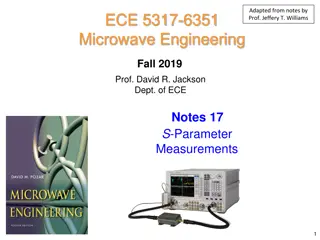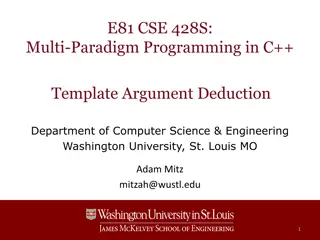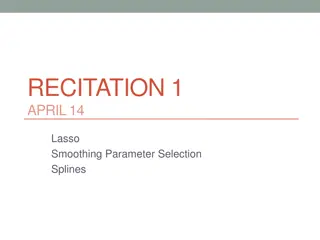Intra-Distillation for Parameter Optimization
Explore the concept of parameter contribution in machine learning models and discuss the importance of balancing parameters for optimal performance. Introduce an intra-distillation method to train and utilize potentially redundant parameters effectively. A case study on knowledge distillation illust
8 views • 31 slides
Parameter and Feature Recommendations for NBA-UWB MMS Operations
This document presents recommendations for parameter and feature sets to enhance the NBA-UWB MMS operations, focusing on lowering testing costs and enabling smoother interoperations. Key aspects covered include interference mitigation techniques, coexistence improvements, enhanced ranging capabiliti
4 views • 18 slides
Parameter Expression Calculator for Efficient Parameter Estimation from GIS Data
Parameter Expression Calculator within HEC-HMS offers a convenient tool to estimate loss, transform, and baseflow parameters using GIS data. It includes various options such as Deficit and Constant Loss, Green and Ampt Transform, Mod Clark Transform, Clark Transform, S-Graph, and Linear Reservoir. U
3 views • 5 slides
IEEE 802.11-21/0036r0 BSS Parameter Update Clarification
This document delves into the IEEE 802.11-21/0036r0 standard, specifically focusing on the BSS parameter update procedure within TGbe D0.2. It details how an AP within an AP MLD transmits Change Sequence fields, Critical Update Flags, and other essential elements in Beacon and Probe Response frames.
2 views • 11 slides
Root Locus Method in Control Systems
The root locus method in control systems involves tracing the path of roots of the characteristic equation in the s-plane as a system parameter varies. This technique simplifies the analysis of closed-loop stability by plotting the roots for different parameter values. With the root locus method, de
1 views • 41 slides
S-Parameter Measurements in Microwave Engineering
S-Parameter measurements in microwave engineering are typically conducted using a Vector Network Analyzer (VNA) to analyze the behavior of devices under test (DUT) at microwave frequencies. These measurements involve the use of error boxes, calibration techniques, and de-embedding processes to extra
1 views • 20 slides
Overview of Subprograms in Software Development
Subprograms in software development provide a means for abstraction and modularity, with characteristics like single entry points, suspension of calling entities, and return of control upon termination. They encompass procedures and functions, raising design considerations such as parameter passing
5 views • 25 slides
Enhancing Ecological Sustainability through Gamified Machine Learning
Improving human-computer interactions with gamification can help understand ecological sustainability better by parameterizing complex models. Allometric Trophic Network models analyze energy flow and biomass dynamics, but face challenges in parameterization. The Convergence Game in World of Balance
1 views • 12 slides
Code Assignment for Deduction of Radius Parameter (r0) in Odd-A and Odd-Odd Nuclei
This code assignment focuses on deducing the radius parameter (r0) for Odd-A and Odd-Odd nuclei by utilizing even-even radii data from 1998Ak04 input. Developed by Sukhjeet Singh and Balraj Singh, the code utilizes a specific deduction procedure to calculate radius parameters for nuclei falling with
1 views • 12 slides
Learning to Rank in Information Retrieval: Methods and Optimization
In the field of information retrieval, learning to rank involves optimizing ranking functions using various models like VSM, PageRank, and more. Parameter tuning is crucial for optimizing ranking performance, treated as an optimization problem. The ranking process is viewed as a learning problem whe
1 views • 12 slides
Efficient Parameter-free Clustering Using First Neighbor Relations
Clustering is a fundamental pre-Deep Learning Machine Learning method for grouping similar data points. This paper introduces an innovative parameter-free clustering algorithm that eliminates the need for human-assigned parameters, such as the target number of clusters (K). By leveraging first neigh
0 views • 22 slides
CEPC Partial Double Ring Parameter Update
The CEPC Partial Double Ring Layout features advantages like accommodating more bunches at Z/W energy, reducing AC power with crab waist collision, and unique machine constraints based on given parameters. The provided parameter choices and updates aim to optimize beam-beam effects, emittance growth
0 views • 14 slides
Foundations of Parameter Estimation and Decision Theory in Machine Learning
Explore the foundations of parameter estimation and decision theory in machine learning through topics such as frequentist estimation, properties of estimators, Bayesian parameter estimation, and maximum likelihood estimator. Understand concepts like consistency, bias-variance trade-off, and the Bay
0 views • 15 slides
Estimation and Statistical Inference in Data Analysis
Statistical inference involves acquiring information and drawing conclusions about populations from samples using estimation and hypothesis testing. Estimation determines population parameter values based on sample statistics, utilizing point and interval estimators. Interval estimates, known as con
0 views • 41 slides
Sampling and Parameter Fitting with Hawkes Processes
Learn about sampling and parameter fitting with Hawkes processes in the context of human-centered machine learning. Understand the importance of fitting parameters and sampling raw data event times. Explore the characteristics and fitting methods of Hawkes processes, along with coding assignments an
1 views • 20 slides
Linear Classifiers and Naive Bayes Models in Text Classification
This informative content covers the concepts of linear classifiers and Naive Bayes models in text classification. It discusses obtaining parameter values, indexing in Bag-of-Words, different algorithms, feature representations, and parameter learning methods in detail.
0 views • 38 slides
Insight into Tuning Check and Parameter Reconstruction Process
Delve into the process of tuning check and parameter reconstruction through a series of informative images depicting old tuning parameters and data sets. Explore how 18 data and 18 MC as well as 18 MC and 12 MC old tuning parameters play a crucial role in optimizing performance and accuracy. Gain va
0 views • 4 slides
Enhancement of TWT Parameter Set Selection in September 2017
Submission in September 2017 proposes improvements in TWT parameter selection for IEEE 802.11 networks. It allows TWT requesting STAs to signal repeat times, enhancing transmission reliability and reducing overheads. Non-AP STA challenges and current TWT setup signaling are addressed, providing a me
0 views • 12 slides
Hyper-Parameter Tuning for Graph Kernels via Multiple Kernel Learning
This research focuses on hyper-parameter tuning for graph kernels using Multiple Kernel Learning, emphasizing the importance of kernel methods in learning on structured data like graphs. It explores techniques applicable to various domains and discusses different graph kernels and their sub-structur
0 views • 20 slides
Metalearning and Hyper-Parameter Optimization in Machine Learning Research
The evolution of metalearning in the machine learning community is traced from the initial workshop in 1998 to recent developments in hyper-parameter optimization. Challenges in classifier selection and the validity of hyper-parameter optimization claims are discussed, urging the exploration of spec
2 views • 32 slides
Confidence Limits in Statistical Analysis
Confidence limits are a crucial concept in statistical analysis, representing the upper and lower boundaries of confidence intervals. They provide a range of values around a sample statistic within which the true parameter is expected to lie with a certain probability. By calculating these limits, r
1 views • 4 slides
Confidence Limits in Parameter Estimation
Confidence limits are commonly used to summarize the probability distribution of errors in parameter estimation. Experimenters choose both the confidence level and shape of the confidence region, with customary percentages like 68.3%, 95.4%, and 99%. Ellipses or ellipsoids are often used in higher d
1 views • 16 slides
ChirpRfFreqSlope Changes Overview
In this content, different settings of ChirpRfFreqSlope parameter are explored with values of 10, 35, 75, and 140 MHz/us. The parameter variations are analyzed within a radar system configuration involving channel settings, chirp timing, frame configuration, signal processing chain, and more. The im
0 views • 8 slides
Creating Easy-to-Read Alloy Models
Oftentimes, Alloy models can become unreadable due to parameter structures. Learn how to enhance readability by considering atomic values as the first parameter and by changing parameter order. Explore examples and best practices for creating clear and concise Alloy models.
0 views • 5 slides
Exploiting Data Distribution in Distributed Learning of Deep Classification Models
Deep learning is prevalent in various applications due to higher classification accuracy, but training complex models can be time-consuming. Distributed learning architectures aim to reduce synchronization overheads, with the parameter server architecture minimizing delays from stale gradients. This
0 views • 9 slides
CEPC Local Double Ring Scheme Parameter Study and IR Design
This study focuses on the parameter study and IR design for the CEPC local double ring scheme. It discusses machine constraints, given parameters, energy acceptance, emittance growth, beam lifetime limitations, effective bunch length, and more. The research aims to optimize the CEPC scheme for enhan
0 views • 16 slides
CH. 4: Parametric Methods
Parametric methods play a crucial role in statistics, focusing on parameter estimation and classification based on given samples. This involves estimating parameters and defining functions such as distribution and regression functions. Maximum likelihood estimation and Bayesian approaches are key me
0 views • 40 slides
Estimating Standard Error Using Bootstrap Method
The bootstrap method is a computer-based technique for estimating the standard error of a parameter regardless of its mathematical complexity. It involves creating multiple samples by resampling from the original data and can be used for various statistical analyses including curve fitting, eigenval
0 views • 36 slides
Rasch Models within B-GLIRT Framework
This study delves into Rasch models within the B-GLIRT framework and explores simplistic Rasch models providing detailed item-level parameter information. The research includes discussions, simulation studies on parameter recovery, and an example of an Educational Evaluation test for higher educatio
0 views • 16 slides
Hough Transforms, Templates, and HOG Features in Image Recognition
In this content, you will delve into the world of Hough transforms, template matching, and HOG features for image recognition. Explore how these techniques help in detecting shapes in real, noisy images using voting procedures in parameter space. Learn the concepts behind line detection, template ma
0 views • 45 slides
Multi-Paradigm Programming in C++ Template Argument Deduction
Compiler utilizes arguments in function templates to determine parameter types and allow for type conversions. Learn about template type parameter conversions, function template explicit arguments, trailing returns and type transformation, and function pointers and references in multi-paradigm progr
0 views • 8 slides
Data-Driven Parameter Estimation for Complex Physics Models
Dive into the world of data-driven parameter estimation for complex physics models without using ensembles or gradients. Explore the challenges and approaches to estimating unknown parameters in large-scale physics-based models. Understand the complexities of modeling high-dimensional systems and th
0 views • 23 slides
Online Parameter Optimization for Elastic Data Stream Processing
This research discusses the optimization of parameters for elastic data stream processing systems, aiming to balance cost and quality of service through automatic scaling based on workload needs. Various aspects such as cloud system utilization, manual parameter settings, and threshold-based scaling
0 views • 20 slides
Bayesian Parameter Estimation for Gaussians in Probabilistic Machine Learning
Explore Bayesian parameter estimation for Gaussians in probabilistic machine learning, focusing on fully Bayesian inference instead of MLE/MAP methods. Understand how the posterior distribution evolves with increasing observations and the implications for parameter estimation.
0 views • 17 slides
Advancing Human Cell Simulation: Modeling and Parameter Estimation
Explore the cutting-edge project on human cell simulation, combining multiple modeling approaches and offloading computations on GPUs. Learn about the challenges in missing parameter estimation and the use of evolutionary algorithms for optimization.
0 views • 10 slides
BSS Parameter Update for Multi-link Operation in IEEE 802.11-20
Explore the concept of BSS parameter updates for multi-link operation in the IEEE 802.11-20 standard. Learn about the notification mechanisms and the significance of these updates for efficient operation of non-AP MLD devices with multiple links.
0 views • 13 slides
Investigating Identifiability in Hybrid Symbolic-Numeric Methods
Explore an extension to the hybrid symbolic-numeric method for detecting parameter redundancy and estimable parameter combinations in complex models. Learn how to apply the hybrid method along with subset profiling to automatically identify relationships between confounded parameters.
0 views • 16 slides
Parameter Passing and Variable Handling in Function Calls
Explore the concepts of parameter passing, variable storage, and value propagation in function calls, covering topics like storing variables, different styles of parameter passing, L- and R-values, memory references, and types of parameter passing. Dive into the nuances of pass-by-value and pass-by-
0 views • 21 slides
Learn Parameter Estimation Techniques at INFN School of Statistics 2022
Join the hands-on session on parameter estimation at INFN School of Statistics in Paestum led by Glen Cowan from Royal Holloway, University of London. Explore exercises and solutions, and gain insights into fitting methods using Python and ROOT/C++. Enhance your skills in data analysis and model fit
0 views • 9 slides
Understanding Lasso Smoothing Parameter Selection and Splines
Explore the intricacies of lasso smoothing parameter selection, sparsity intuition, solution paths, and piecewise polynomials/splines in data modeling. Learn about various techniques like leave-one-out cross-validation, regression splines, and smoothing splines for effective model building. Discover
0 views • 11 slides







































